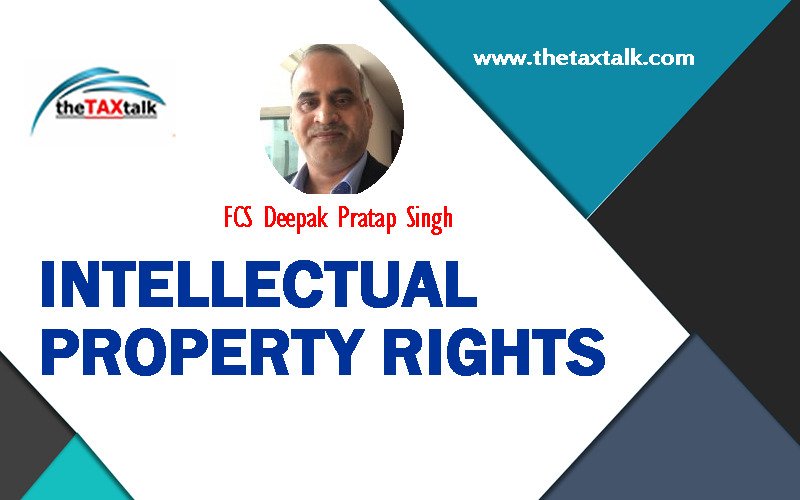![]()
INTELLECTUAL PROPERTY RIGHTS
Author
FCS Deepak Pratap Singh
Intellectual Property is the creative work of human intellect. For development of each country its human workforce plays a vital role. The level of intelligence and its protection are the key to success for every nation. The world today is running on the basis of natural resources and human intellect. For utilisation of natural resources also required human intelligence. The intellectual properties of every nation should be protected, to promote the progress in science and technology, art, literature and other creative works. The protection of intellectual property and rights of its creator, will boots economy of country and encourage more and more creativity. The economic and technological development of a national will come to a halt if protection is not given to its “Intellectual Property Rights”.
WHAT ARE INTELLECTUAL PROPERTY RIGHTS;
Intellectual property is the product of the human intellect including creativity concepts, inventions, industrial models, trademarks, songs, literature, symbols, names, brands, etc. Intellectual Property Rights do not differ from other property rights. They allow their owner to completely benefit from his/her product which was initially an idea that developed and crystallized. They also entitle him/her to prevent others from using, dealing or tampering with his/her product without prior permission from him/her. He/she can in fact legally sue them and force them to stop and compensate for any damages.
WIKIPEDIA
Intellectual property (IP) is a category of property that includes intangible creations of the human intellect. There are many types of intellectual property, and some countries recognize more than others. The most well-known types are copyrights, patents, trademarks, and trade secrets.
The main purpose of intellectual property law is to encourage the creation of a wide variety of intellectual goods. To achieve this, the law gives people and businesses property rights to the information and intellectual goods they create, usually for a limited period of time. This gives economic incentive for their creation, because it allows people to profit from the information and intellectual goods they create. These economic incentives are expected to stimulate innovation and contribute to the technological progress of countries, which depends on the extent of protection granted to innovators.
WORLD TRADE ORGANISATION;
Intellectual property rights are the rights given to persons over the creations of their minds. They usually give the creator an exclusive right over the use of his/her creation for a certain period of time.
Intellectual property relates to pieces of information which can be incorporated in tangible objects at the same time in an unlimited number of copies of different location anywhere in the world. The property is not in those pieces but the information reflected in those pieces. The information, concept, ideas and a creative work of a human being make him intellectual. The new concepts, art, innovations, machine, design, thought, literatures, apparatus, etc. are treated as intellectual properties and it gives the creator, artist, scientist exclusive right to exploit its creation for economic development.
Article 2(viii) of Convention Establishing, the World Intellectual Property Organisation (WIPO), 1967 provides that “Intellectual Property” includes rights relating to;
-
Literary, artistic, and scientific works;
-
Performance of performing artists, phonograms and broadcasts;
-
Inventions in all fields of human endeavour;
-
Trademarks, service marks and commercial name and designations;
-
Protection against unfair competition and all other rights resulting from intellectual activities in the industrial, scientific, literary and artistic fields.
The Intellectual Property thus, includes
-
Copyrights;
-
Trademarks;
-
Service Marks;
-
Geographical Indications;
-
Patents;
-
Utility Models;
-
Plant Varieties;
-
Industrial Designs;
-
Trade Secrets;
-
Layout Design of integrated circuits etc.
LET’S CONSIDER ONE BY ONE
-
COPY RIGHTS
In India Copy Rights subsists in
-
original literary, dramatic, musical and artistic works;
-
cinematographs films and
-
sound recordings.
The subject matter of copyright includes e.g. poems, catalogues, consignment note, directories, mathematical tables, railway timetables, road books, guide books, scientific questions and answers, rules of game, stud books, trade statistics, any piece for recitation, choreographic works or entertainment in dumb show, the science arrangements or acting form which can be written, sound recordings, films, a painting, sculpture, drawings, an engraving or a photograph etc., whether or not any such work possesses artistic quality , literary works also includes computer programming.
The Copyright Law generally provides to the owner of copyright the right to;
-
reproduce the work in any material form;
-
to issue copies of the work to the public;
-
to perform work in public;
-
to communicate it to public;
-
to make any cinematographic film or sound recording in respect to those work;
-
to make translation of work;
-
to make adoption of works, etc.
2. INDUSTRIAL PROPERTY;
Industrial property is a kind of intellectual property and thus relates to creation of human mind. Such creations are mainly inventions and industrial designs. Since inventions are the new solutions to technological problems, and industrial designs are aesthetic creations determining appearance of industrial products. Apart from this Industrial Property includes Patents, Trademarks, Services Marks, Layouts-designs of integrated circuits, commercial name and designations, as well as geographical indications, and protection against unfair competition.
2.1 PATENTS
Patent means monopoly right granted to a person by Patent Office to exploit his invention for a limited period of time. In India patent right generally granted for a period of 20 years. The inventor or patent holder during this period exclude anyone else from commercially exploiting his invention. The person to whom patent granted by law is called “Patentee” and any person can exploit his /her invention during patent period with exclusive permission of patentee.
The grant of patent not only recognize and rewards the creativity of the inventor but also acts as an inspiration or catalyst for further inventions which ultimately contributes to the technological developments of a nation.
2.2 TRADE MARKS
A trade mark includes any device, brand, heading, label, ticket, name, signature, word, letter, numeral, shape of goods, packaging or combination of colours or any combination thereof.
Section 2(1) (zb) of Trade Marks Act, 1999 states that a trade mark should be capable of being represented graphically and should be capable of distinguishing the goods or services of one person from others.
The main purposes of Trade Marks law is;
-
It protects the public from confusion and deception by identifying the source or origin of a particular products as distinguished from similar other products;
-
It protects the trade mark owner’s trade and business as well as the goodwill is attached to his trade mark.
2.2.1 CERTIFICATION TRADE MARK;
A mark capable of distinguishing the goods or services in connection with which it is used in the course of trade which are certified by the proprietor of mark in respect of origin, material, mode of manufacture of goods or performance of services ,quality ,accuracy or other characteristic from goods or services not so certified and registrable as such under Chapter IX of the Trade Marks Act, 1999 in respect of those goods or services in the name , as proprietor of the certification trade mark of that person.
2.2.2 COLLECTIVE MARK;
Collective Mark means a trade mark distinguishing the goods or services of members of an association of persons not being a partnership which is the proprietor of the mark from those of others.
2.2.3 TRADE FOR GOOD AND SERVICES
A trade mark may be registered for goods and services.
“Goods” includes anything which is the subject of trade of trade or manufacture.
“Services” includes service of any description which is made available to potential users and includes the provision of services in connection with business of any industrial or commercial matters such as banking, communication, education, financing, insurance, chit funds, real estate, transport, storage, material treatment, processing ,supply of electrical or other energy, boarding lodging ,entertainment ,amusement ,construction ,repair conveying of news or information and advertising.
2.2.4 DOMAIN NAME;
A Domain Name could be said to be a word or name which is capable of distinguishing the subject of trade or service made available to potential users of the Internet. A domain name may have all characteristics of a trade mark.
2.2.5 DESIGNS;
It means only features of shape , configuration, pattern, ornament or composition of lines or colours applied to any article whether in two dimensional or three dimensional or in both forms , by any industrial process or means, whether manual , mathematical or chemical ,separate or combined, which in the finished article appeal to and are judge solely by the eye.
Design consists of;
-
Three-dimensional features, such as the shape of a product;
-
Two-dimensional features, such as ornaments, patterns, lines or coloursof a product or;
-
A combination of one or more such features.
Design must be such that in the finished article the features of it “appeal to and judge by eye”. A good subject of design must be visually appealing, though it need not be an artistic work.
2.2.6 PLANT VARIETIES;
A new plant variety, which confirms novelty, distinctiveness, uniformity and stability shall be registrable under provision of Protection of Plant Varieties and Farmers’ Right Act, 2001. The criteria of novelty are not applicable in case of extant variety. Plant variety should be new, innovative, distinguishable from existing varieties of plants.
An extant variety is registrable in India within specified time if it conforms to such criteria of distinctiveness, uniformity and stability.
TRIPs which obligates members to protect plant varieties either by patents or by an effective sui generis system or by any combination thereof.
2.2.7 GEOGRAPHICAL INDICATIONS;
It indicates that particular goods originate from particular nation or geographical area, locality and has some special characteristics, qualities or reputation, which are attributable to its place of origin. The special characteristics , qualities or reputation may be due to various factors e.g. natural factors such as raw materials, soil, regional climate, temperatures, moisture etc. or method of manufacture or preparation of the product as traditional production methods; or other human factors such as concentration of similar business in the same region, specialisation in production or preparation of certain products and maintaining of certain quality standards.
We know that how geographical indications affects sale of a product as well as its qualities. The connection between the goods and place becomes so famous that any reference to the place reminds the goods being produced there and vice-versa. For example, reference to District of Champagne, Porto, Sherry, Vodka, Real California etc.
Geographical indications generally perform three functions;
-
Firstly, the identify goods as originated in particular territory or region or locality;
-
They suggest the consumers that the goods come from an area where a given quality, reputation or characteristic of the goods is essentially attributable to their geographical origin;
-
They promote goods of production of a particular area.


